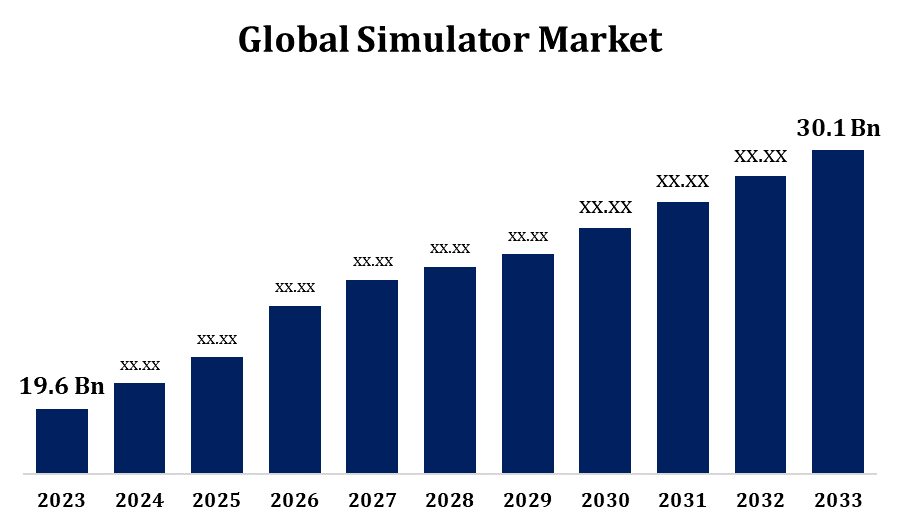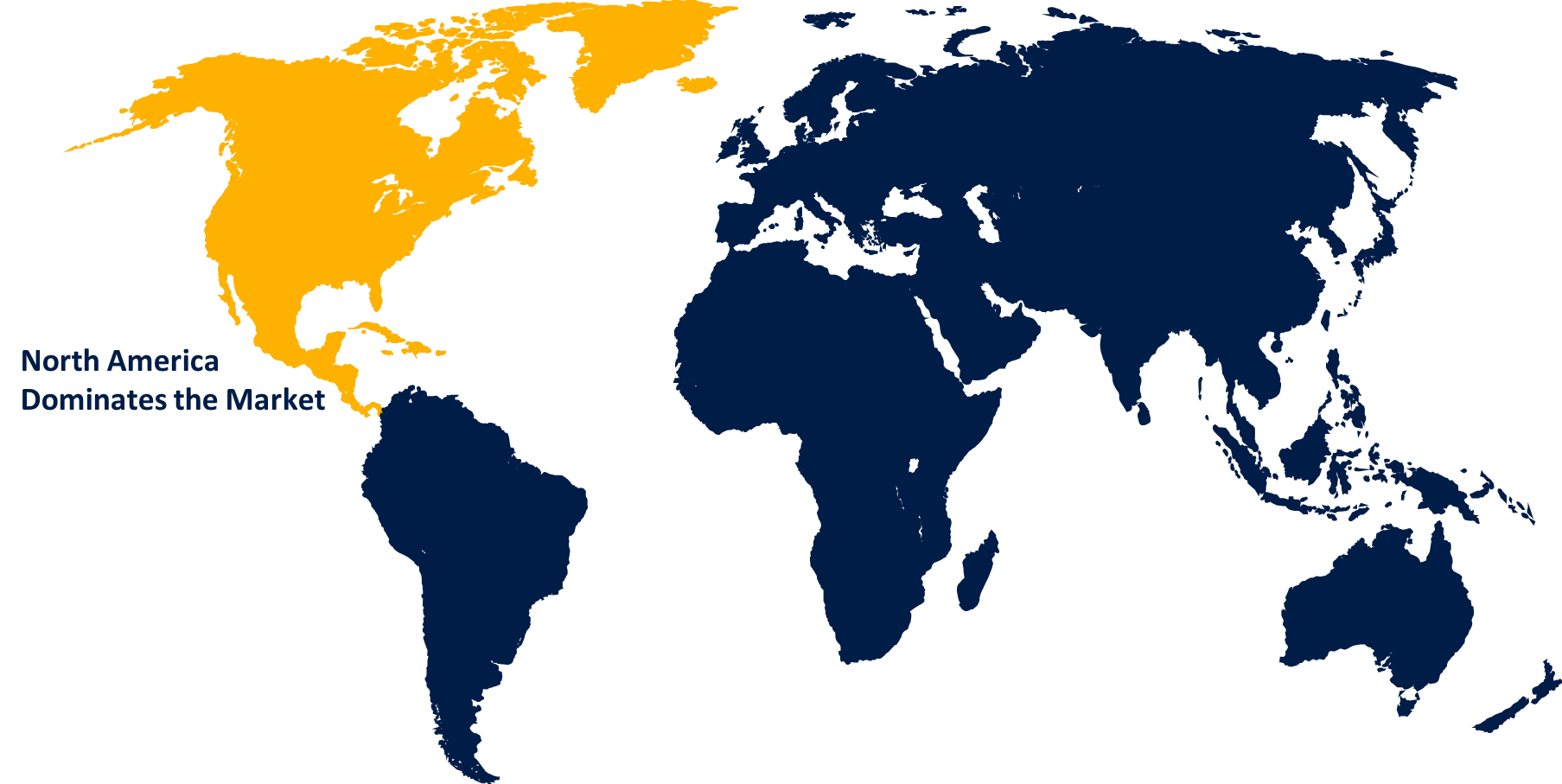Global Simulator Market Size, By Application (Training, Research & Development, Others), By Type (Full Flight Simulation, Fixed Base Simulation, Driving Simulation, Others), By End Use Industry (Aerospace & Defense, Automotive, Marine & Naval, Media & Entertainment), By Region, And Segment Forecasts, By Geographic Scope And Forecast to 2033
Industry: Aerospace & DefenseGlobal Simulator Market Insights Forecasts to 2033
- The Global Simulator Market was valued at USD 19.6 Billion in 2023.
- The Market is Growing at a CAGR of 4.38% from 2023 to 2033
- The Worldwide Simulator Market Size is expected to reach USD 30.1 Billion by 2033
- Asia Pacific is expected to Grow the fastest during the forecast period

Get more details on this report -
The global Simulator Market is expected to reach USD 30.1 billion by 2033, at a CAGR of 4.38% during the forecast period 2023 to 2033.
Simulators are used in many industries for teaching, research, entertainment, and other purposes. This market covers a wide variety of applications, such as flight simulation, driving simulation, military training simulators, virtual reality (VR), and augmented reality (AR) simulations, among others. As technology advances, the simulator business expands and diversifies, with advancements like VR and AR creating new potential for immersive simulation experiences. Furthermore, the growing use of simulation technology in industries such as healthcare, education, and gaming is broadening the breadth of the industry. Moreover, the market experiences momentum due to rising demands for training, skill enhancement, and risk management across multiple sectors. Simulation emerges as a cost-efficient and effective substitute for conventional training approaches, presenting avenues for research, experimentation, and analysis.
Simulator Market Value Chain Analysis
The simulator market's value chain encompasses a series of interconnected stages, beginning with research and development into advanced simulation technologies. Manufacturers produce hardware components and software developers create tailored simulation applications, which integrators assemble into customized systems. Distributors handle product distribution, while sales teams engage with clients to understand their needs. Training providers offer education on system operation, while technical support teams provide assistance. End users across industries utilize simulation for training, research, and entertainment. Maintenance contracts ensure system reliability, while feedback informs future innovation efforts, completing the value chain loop and driving competitiveness in the market.
Simulator Market Opportunity Analysis
The simulator market presents significant opportunities driven by growing demands for training, skill development, and risk mitigation across diverse industries. With simulation offering cost-effective and efficient alternatives to traditional training methods, there's ample scope for innovation and expansion. Moreover, simulation technology opens avenues for research, experimentation, and analysis, further enhancing its value proposition. As industries increasingly recognize the benefits of simulation, including improved safety, reduced costs, and enhanced training effectiveness, the market is poised for sustained growth. Emerging technologies like virtual reality (VR) and augmented reality (AR) are also fueling market expansion, creating new opportunities for immersive simulation experiences. Overall, the simulator market is ripe with potential for companies to capitalize on evolving industry needs and technological advancements.
Global Simulator Market Report Coverage
| Report Coverage | Details |
|---|---|
| Base Year: | 2023 |
| Market Size in 2023: | USD 19.6 Billion |
| Forecast Period: | 2023-2033 |
| Forecast Period CAGR 2023-2033 : | 4.38% |
| 2033 Value Projection: | USD 30.1 Billion |
| Historical Data for: | 2019-2022 |
| No. of Pages: | 200 |
| Tables, Charts & Figures: | 120 |
| Segments covered: | By Application, By Type, By End Use Industry, By Region. |
| Companies covered:: | CAE Inc. (US), L3Harris Technologies Inc. (US), Thales Group (France), Saab AB (Sweden), Indra (Spain), Flight Safety International (US), Boeing (US), Raytheon Technologies Corporation (US), Airbus S.A.S. (Netherlands), and other key vendors. |
| Growth Drivers: | Increasing need for military, aviation, and navy training will drive market growth. |
| Pitfalls & Challenges: | COVID-19 Empact, Challenge, Future, Growth, & Analysis |
Get more details on this report -
Market Dynamics
Simulator Market Dynamics
Increasing need for military, aviation, and navy training will drive market growth.
The demand for simulator training in the military, aviation, and naval sectors has continuously increased. Simulators provide a safe, cost-effective, and efficient means to educate personnel in a variety of scenarios, including aircraft manoeuvres and combat simulations. As technology advances, these simulators become more sophisticated, providing highly realistic landscapes and scenarios that closely resemble real-world events. As military operations and aircraft missions become more complicated, the significance of effective simulation training grows. This trend is expected to fuel significant growth in the simulator industry, as defence forces and aviation organisations prioritise readiness and competency through enhanced training solutions.
Restraints & Challenges
Simulators can be expensive to create, maintain, and use. High initial investment costs might be prohibitive for some organisations, particularly smaller ones or those operating in poor nations. Achieving high degrees of realism and accuracy is critical to simulator efficacy. Simulators must provide realistic feedback and responses to user input, which necessitates advanced modelling and simulation approaches. In educational environments, incorporating simulators into current curricula might be difficult. Educators must ensure that simulator-based training is aligned with learning objectives and complements other instructional modalities. The simulator market is highly competitive, with multiple manufacturers providing a diverse range of goods and solutions. Standing out in a crowded market necessitates ongoing innovation, quality assurance, and successful marketing tactics.
Regional Forecasts
North America Market Statistics

Get more details on this report -
North America is anticipated to dominate the Simulator Market from 2023 to 2033. North America is home to a large share of the worldwide aviation sector, including major aircraft manufacturers, airlines, and training facilities. Aviation simulators, such as flight simulators and maintenance training devices, are widely used for pilot training, aircraft maintenance, and emergency procedure drills. Medical simulation is becoming increasingly popular in North America, with simulators used for medical education, training, and patient care. Healthcare simulation has numerous applications, including surgical simulation, patient simulation, medical procedure training, and virtual reality-based therapy. With its extensive network of roads and highways, North America has a huge market for driving simulators. These simulators are used for driver training, assessment, and research into autonomous vehicle technologies.
Asia Pacific Market Statistics
Asia Pacific is witnessing the fastest market growth between 2023 to 2033. With Asia-Pacific being one of the world's fastest-growing aviation markets, there is an increased demand for aviation simulators for pilot training, aircraft maintenance, and air traffic control training. Major airlines, aircraft manufacturers, and training facilities in China, India, Singapore, and Australia are investing in advanced simulation technologies. Several Asia-Pacific countries are increasing their defence capabilities, which is driving increased demand for military simulation systems. These simulators are used to train military personnel in a variety of skills, including flight training, warfare scenarios, weapon system operation, and mission planning. The healthcare business in Asia-Pacific is rapidly expanding its simulation-based training programmes for medical workers. Medical simulation is utilised for surgical training, patient care simulations, and medical education.
Segmentation Analysis
Insights by Type
The full flight simulation segment accounted for the largest market share over the forecast period 2023 to 2033. As global air travel expands, so does the demand for well-trained pilots. Full Flight Simulators offer a realistic training environment in which pilots can practise numerous scenarios and procedures without the use of actual aircraft. As more airlines grow their fleets and itineraries, the demand for pilot training, including FFS usage, is projected to increase. The expansion of low-cost airlines (LCCs) in many countries has boosted demand for pilot training services. LCCs frequently seek cost-effective training options, and Full Flight Simulators provide great training quality without the requirement for costly aircraft operations. This trend has helped to drive the expansion of the FFS industry.
Insights by Application
The training segment is dominating the market with the largest market share over the forecast period 2023 to 2033. Across industries, there is an increasing demand for competent people who have the essential knowledge and competencies to do their tasks well. Simulator-based training provides a safe and controlled environment for hands-on learning, allowing learners to develop and practise critical skills without jeopardising their safety or expensive equipment. As businesses become more global and markets expand into new countries, there is a growing demand for standardised training programmes that can be given consistently across several locations. Simulators provide a scalable and adaptable training system that can be implemented internationally, ensuring consistent training results. Simulator-based training can be more cost-effective than traditional techniques, especially in industries where real-world training is prohibitively expensive or unsafe.
Insights by End Use
The aerospace and defence segment accounted for the largest market share over the forecast period 2023 to 2033. The worldwide aircraft sector is seeing expansion in commercial air travel, which is increasing the demand for well-trained pilots. Simulators, particularly Full Flight Simulators (FFS) and Flight Training Devices (FTD), play an important role in pilot training because they provide realistic and immersive teaching settings without the use of actual aircraft. Defence forces worldwide are investing in advanced simulation technology to improve training effectiveness and preparedness. Military simulators are used to train pilots, ground crew, and mission planners in a variety of scenarios, including aerial warfare, mission rehearsal, and emergency response. The rising complexity of current military operations needs high-fidelity simulation technologies.
Recent Market Developments
- In July 2023, Iran successfully demonstrated the MiG-29 simulator to enhance the fighting capability of its armed forces. Shahid Sattari Aeronautical University launched electronic warfare simulations using Su-24 and F-4 fighter jets.
Competitive Landscape
Major players in the market
- CAE Inc. (US)
- L3Harris Technologies Inc. (US)
- Thales Group (France)
- Saab AB (Sweden)
- Indra (Spain)
- Flight Safety International (US)
- Boeing (US)
- Raytheon Technologies Corporation (US)
- Airbus S.A.S. (Netherlands)
Market Segmentation
This study forecasts revenue at global, regional, and country levels from 2023 to 2033.
Simulator Market, Type Analysis
- Full Flight Simulation
- Fixed Base Simulation
- Driving Simulation
- Others
Simulator Market, Application Analysis
- Training
- Research & Development
- Others
Simulator Market, End Use Analysis
- Aerospace & Defense
- Automotive
- Marine & Naval
- Media & Entertainment
Simulator Market, Regional Analysis
- North America
- US
- Canada
- Mexico
- Europe
- Germany
- Uk
- France
- Italy
- Spain
- Russia
- Rest of Europe
- Asia Pacific
- China
- Japan
- India
- South Korea
- Australia
- Rest of Asia Pacific
- South America
- Brazil
- Argentina
- Rest of South America
- Middle East & Africa
- UAE
- Saudi Arabia
- Qatar
- South Africa
- Rest of Middle East & Africa
Frequently Asked Questions (FAQ)
-
1. What is the market size of the Simulator Market?The Global Simulator Market Size is expected to Grow from USD 19.6 Billion in 2023 to USD 30.1 Billion by 2033, at a CAGR of 4.38% during the forecast period 2023-2033.
-
2. Who are the key market players of the Simulator Market?Some of the key market players of the market are CAE Inc. (US), L3Harris Technologies Inc. (US), Thales Group (France), Saab AB (Sweden), Indra (Spain), Flight Safety International (US), Boeing (US), Raytheon Technologies Corporation (US), Airbus S.A.S. (Netherlands).
-
3. Which segment holds the largest market share?The training segment holds the largest market share and is going to continue its dominance.
-
4. Which region is dominating the Simulator Market?North America is dominating the Simulator Market with the highest market share.
Need help to buy this report?